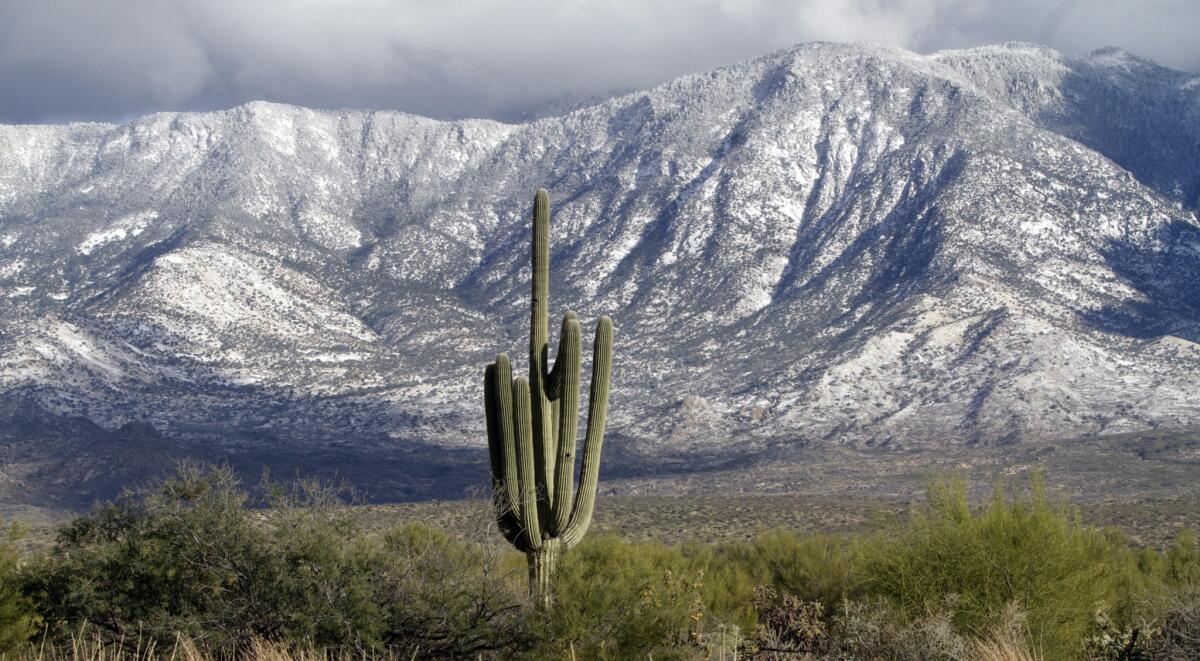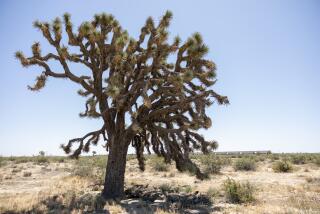Charles Bowden grimly chronicled the toughest stories of the U.S.-Mexico border. But he was once full of hope

When Charles Bowden died in 2014, America lost one of its most intrepid investigative journalists covering U.S. border policy and the desert Southwest. The job was grueling and heart-wrenching, and it showed: The decades he spent reporting put cracks and wrinkles in his writing. In “Murder City,” his 2010 book about cartel violence in Ciudad Juarez, Mexico, he often sounded utterly defeated about the world he wrote about and whether anybody would want to bear witness alongside him. “We are in a place without beginning or end, and all the ways to tell the story fail me and repel me,” he wrote.
The University of Arizona Press has reissued two of Bowden’s earliest books, 1986’s “Blue Desert” and 1987’s “Frog Mountain Blues,” and to read them after “Murder City” is to feel emotionally whipsawed. To the last, he never abandoned his righteous indignation over unchecked urban expansion and mistreatment of Native Americans and migrants. But in the mid-’80s a sense of resignation hadn’t kicked in yet. These two early books also reveal a lyricism, grace and — not unimportantly — sense of hope. Together, they show how prescient he was about the transformation of the Southwest. They also open up a question that’s become only more urgent in the three decades since they were published: How do we talk about that transformation in a way that will get people to listen?
In the mid-’80s, Bowden’s strategy was simple: Try anything. He shared folk tales as if sitting by a campfire, relating the fable of the Mine With the Iron Door, a mythical cache of gold that drew miners and priests to the Tucson Mountains in the 18th century. He delivered sharp-elbowed reportage about the Agua Caliente tribe in Palm Springs, fleeced by developers for decades and made all the more exploitable thanks to myths that they are “millionaires who drive Cadillacs … victors in the centuries-long struggle between native Americans and white people.” He hiked 130 miles from the Gulf of California coast in Mexico to the dying Arizona mining town of Ajo to better understand the northward path migrants take. It’s a brutal trek, although he never confused his struggles with migrants’. “I am the interloper, the refugee, the tourist, the present that denies the past,” he writes.
Wherever he goes and however he tells the story, though, the target remains the same: the “Sunbelt,” his catch-all term not just for the region of the country stretching from Palm Springs to Tucson, but for the development mind-set that’s willing to run roughshod over land and people in the name of growth. Phoenix can’t expand forever, Bowden insists to the head of a state power company. “Why not?” the man replies. (Phoenix was the ninth most populous U.S. city at the time, with roughly 800,000 inhabitants; it now ranks fifth, with twice as many people.) You can feel Bowden’s fists clenching.
In “Frog Mountain Blues” he writes about growing up in the Midwest and being seduced by the Arizona he read about in pulp westerns, and he was loath to let go of the vision of freedom those stories offered. He didn’t move to Tucson to see the Santa Catalina Mountains filled with resorts and high-priced homes dumping sewage and trash. Bowden feared the worst: “The mountain that suffers with a city of half a million people living at its base will be devoured by the proposed city of a million to a million and a half,” he wrote. It’s a comfort of sorts that Tucson’s population actually hasn’t increased much and that Summerhaven, a mountain resort town there, hasn’t expanded.
But inhumanity at the border has only worsened; Francisco Cantú, a former Border Patrol agent and author of the memoir “The Line Becomes a River,” thoughtfully highlights the contemporary voices with “even greater proximity to the issues that obsessed [Bowden]” in his foreword to “Blue Desert.” And Bowden, who argued that true progress on the mountains demanded stripping it of humanity, wouldn’t see much progress at all today.
He’d tempered his fury, though — his style in both of these books is questioning, satirical, self-deprecating, willing to engage with multiple sides of an argument. As Alison Hawthorne Deming writes in her foreword to “Frog Mountain Blues,” Bowden “was no longer the hothead who leaves the room when he doesn’t like the questions. He was the man who stayed in the room when the hard questions needed to be asked.” He knew the value of a joke too, even if his sense of humor always was cantankerous, if not bleak. “For people who hate to learn the names of things, the world is getting better every day,” he wrote of the rise in endangered and vanished desert species. He lamented the very existence of Phoenix, “a blob parading as a city.”
All Southwestern readers — even blob-ites like myself — are well versed in this kind of conflicted prose, where romantic visions of the desert do battle with laments for how humans (but always some other humans) are destroying it. Has it done any good? In the mid-’80s, it seemed possible. Bowden was picking up the torch that had been carried by Edward Abbey, who helped spark the creation of Earth First! with his 1975 novel, “The Monkey Wrench Gang,” a Twain-ish picaresque that made thwarting Sunbelt developers seem like good fun. Environmentalism went mainstream; the ozone layer got addressed; writers from Latino and Native American backgrounds, who bore the downsides of Sunbelt development, emerged from the shadows.
Yet none of it put a crack in the Glen Canyon Dam that Bowden and Abbey both detested; none of it made a migrant any less at risk of opening a water bottle at a way station and finding it filled with hydrochloric acid, as Bowden once did. But any sense of futility that Bowden felt was also checked by a recognition that he was being heard and had allies — he was a Pulitzer finalist, a PEN Center honoree, a familiar voice in magazine pages, a public firebrand. Just as important, Bowden helped clear the path for a generation of writers who would defend the Southwest in a variety of registers: the unflinching reporting of Alberto Luis Urrea, the keen scientific eye of Barbara Kingsolver, the intimate memoirs of Reyna Grande and Cantú.
Bowden may have spent his final years fearing that his efforts didn’t make a difference. But perhaps it’s enough for one writer to be honest about the damage around him and acknowledge his complicity in it. “We are becoming more and more aware that our civilization destroys the foundations that support it by devouring the earth and the things of the earth,” he wrote in “Blue Desert.” “But we don’t have the courage to back away, to stop, to restrain ourselves. I know I don’t.”
Mark Athitakis is a writer in Phoenix.
::
Charles Bowden
University of Arizona Press: 216 pp., $17.95
Charles Bowden
University of Arizona Press: 224 pp., $19.95
More to Read
Sign up for our Book Club newsletter
Get the latest news, events and more from the Los Angeles Times Book Club, and help us get L.A. reading and talking.
You may occasionally receive promotional content from the Los Angeles Times.









